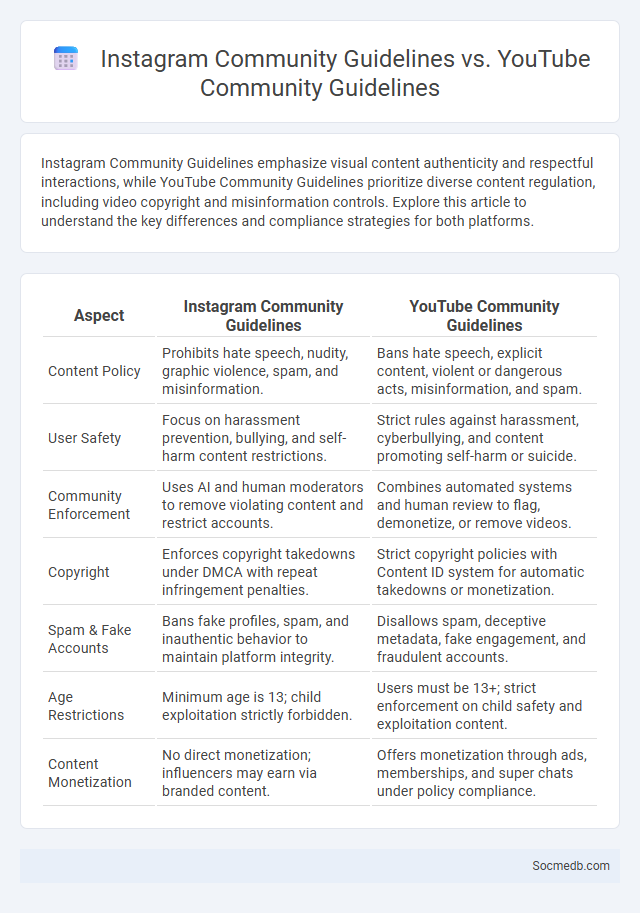
Photo illustration: Instagram Community Guidelines vs YouTube Community Guidelines
Instagram Community Guidelines emphasize visual content authenticity and respectful interactions, while YouTube Community Guidelines prioritize diverse content regulation, including video copyright and misinformation controls. Explore this article to understand the key differences and compliance strategies for both platforms.
Table of Comparison
| Aspect | Instagram Community Guidelines | YouTube Community Guidelines |
|---|---|---|
| Content Policy | Prohibits hate speech, nudity, graphic violence, spam, and misinformation. | Bans hate speech, explicit content, violent or dangerous acts, misinformation, and spam. |
| User Safety | Focus on harassment prevention, bullying, and self-harm content restrictions. | Strict rules against harassment, cyberbullying, and content promoting self-harm or suicide. |
| Community Enforcement | Uses AI and human moderators to remove violating content and restrict accounts. | Combines automated systems and human review to flag, demonetize, or remove videos. |
| Copyright | Enforces copyright takedowns under DMCA with repeat infringement penalties. | Strict copyright policies with Content ID system for automatic takedowns or monetization. |
| Spam & Fake Accounts | Bans fake profiles, spam, and inauthentic behavior to maintain platform integrity. | Disallows spam, deceptive metadata, fake engagement, and fraudulent accounts. |
| Age Restrictions | Minimum age is 13; child exploitation strictly forbidden. | Users must be 13+; strict enforcement on child safety and exploitation content. |
| Content Monetization | No direct monetization; influencers may earn via branded content. | Offers monetization through ads, memberships, and super chats under policy compliance. |
Introduction to Community Guidelines Across Social Platforms
Community guidelines on social media platforms outline the rules and expectations for user behavior to maintain a safe and respectful environment. These guidelines often cover content related to hate speech, harassment, graphic violence, and misinformation, ensuring that Your interactions remain positive and constructive. Adhering to these standards helps protect users, promotes healthy digital communities, and prevents account suspension or removal.
Overview of Instagram Community Guidelines
Instagram Community Guidelines establish clear rules to maintain a safe, respectful, and authentic environment for users worldwide. The platform prohibits hate speech, harassment, graphic violence, and misinformation, enforcing strict measures against content that violates these standards. Users are encouraged to share genuine content while respecting privacy, intellectual property rights, and age restrictions to foster a positive online community.
Overview of YouTube Community Guidelines
YouTube Community Guidelines outline clear rules to maintain a safe, respectful platform by prohibiting harmful content such as hate speech, harassment, and misinformation. Your content must comply with these policies to avoid penalties, including video removal or account suspension, ensuring a positive experience for all users. Understanding these guidelines helps creators protect their channel and foster a trustworthy community.
Defining "Community Guidelines" in Digital Spaces
Community guidelines in digital spaces are a set of rules and standards designed to foster respectful, safe, and inclusive interactions among users on social media platforms. These guidelines regulate content sharing, behavior, and communication to prevent harassment, misinformation, and harmful activities. Enforcing community guidelines helps maintain platform integrity and enhances user experience by promoting positive digital engagement.
Key Differences Between Instagram and YouTube Policies
Instagram's policies emphasize visual content sharing with strict community guidelines targeting image and video appropriateness, privacy, and intellectual property rights. YouTube enforces extensive content rules focusing on video monetization, copyright claims through Content ID, and detailed community standards addressing misinformation and graphic content. Both platforms prioritize user safety and content authenticity but differ significantly in content format regulation and monetization mechanisms.
Content Moderation: Instagram vs YouTube
Content moderation on Instagram prioritizes visual integrity and community guidelines enforcement by using AI-driven image recognition to detect harmful or inappropriate content, ensuring Your posts remain safe and compliant. YouTube combines automated algorithms with human reviewers to manage a vast array of video content, focusing on flagging hate speech, misinformation, and copyright violations effectively. Both platforms continuously update their moderation policies to adapt to evolving online behaviors and regulatory requirements.
Enforcement Mechanisms: Reporting and Penalties
Social media platforms implement enforcement mechanisms by enabling users to report harmful content, spam, or violations of community guidelines directly through integrated reporting tools. Once a report is submitted, automated systems and human moderators assess the content to determine if penalties like content removal, account suspension, or permanent bans are warranted. Your proactive participation in reporting inappropriate behavior helps maintain a safer online environment and ensures that enforcement measures are effectively applied.
User Safety and Protection Measures
Social media platforms implement advanced algorithms and AI-driven tools to detect and prevent harmful content, ensuring user safety. Robust privacy settings and account verification processes protect users from identity theft, phishing, and cyberbullying. Continuous updates to community guidelines and real-time monitoring promote a secure and respectful online environment.
Content Creation and Sharing: Platform-Specific Rules
Effective content creation and sharing on social media require understanding platform-specific rules, such as Instagram's emphasis on high-quality visuals and hashtag usage, TikTok's preference for short, engaging videos, and Twitter's character limit encouraging concise messaging. Adhering to these guidelines ensures your content reaches the intended audience while maximizing engagement. Staying updated on each platform's policies helps protect your account and enhances your overall social media strategy.
Conclusion: Best Practices for Navigating Community Guidelines
Navigating social media community guidelines requires consistent adherence to platform rules and proactive content moderation to avoid violations and account suspensions. You should regularly review updates, engage respectfully with others, and report inappropriate content to maintain a positive online presence. Following these best practices enhances your digital reputation and fosters a safer, more inclusive social environment.
 socmedb.com
socmedb.com